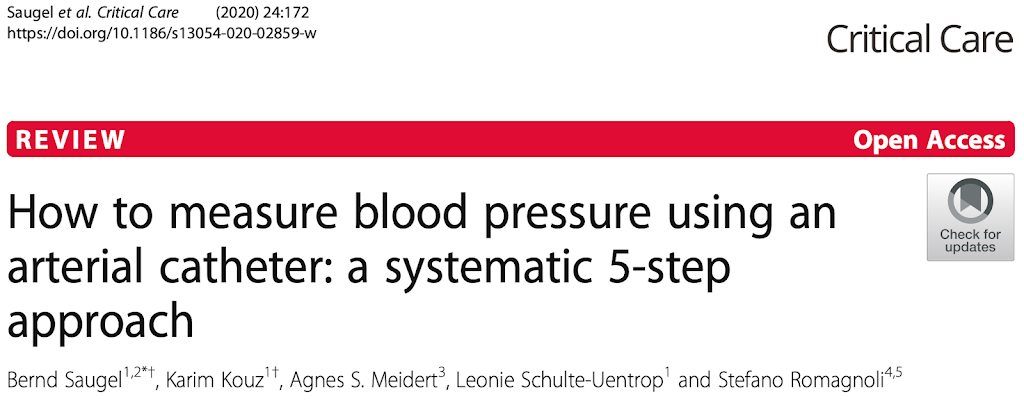Taking a quick COVID break, we’ve had enough of that for now. Let’s get back to some simple critical care basics: measuring blood pressure in the ICU. We do this on all of our patients at least hourly for the stable patients. It is performed continuously on our unstable patients. Ultimately, though, we need to do this right. After all, this is critical care and the details matter.
I have already detailed my concerns with oscillometric BP cuffs in the past. There’s even a YouTube video about it meaning I’ll skip that here.
I also wrote a post on brachial arterial lines here. Ultimately, the values generated by the oscillometric devices leave much to be desired. When someone is sick (everyones definition of what sick is varies) they need an arterial line. Plain and simple. No healthcare professional has ever complained about having an arterial line. Win-win for all involved.
5 Step approach
This paper touches on a 5 step approach to using an arterial line.
Step 1. Catheter insertion sites. I am a fan of brachial artery catheterization, ultrasound (US) guided. First, I tend to look at the radial artery first via US and eyeball the caliber of the vessel. Then, I weigh on complexity of the procedure if they’re on jet fuel to keep them alive and quickly scurry up the arm. I don’t want to spend 2 hours sticking an artery like we have all done at one point or another.
Someone who gloats about how good they are at a-lines hasn’t been humbled enough. I asked my nurse colleagues to grab me a dart as well as the femoral line kit. Before anyone gives me a hard time about my preference for brachial artery preference, please note the complication rate is 0.2%. I have placed a number of axillary lines but this is an option of last resort for me. I choose the femoral route in code situations where I knock out a “dirty double” and place both the central line and arterial line depending on what blood return I get from the stick.
Step 2. Catheter length: I use the 4.45cm catheter for radial arteries and the 16cm catheter for all others. When you place the US probe over the brachial artery you’ll quickly see why the 4.45cm catheter won’t cut it, especially in an extremity with significant adipose tissue.
Step 3 is being skipped.
Step 4 and 5 are primarily for my critical care nursing colleagues as they describe the leveling and zeroing of the transducer, as well as checking the quality of the waveforms. They go further into dampening and a number of key concepts that are much better explained by the authors than I can ever do.
Wrapping it up….
You should definitely check out this article for yourself to learn how to measure blood pressure in the ICU as it is worth your time. Did I mention that it’s free?
Citation:
Saugel, B., Kouz, K., Meidert, A. et al. How to measure blood pressure using an arterial catheter: a systematic 5-step approach. Crit Care 24, 172 (2020). https://doi.org/10.1186/s13054-020-02859-w
Link to website
Link to PDF
Disclaimer
Although great care has been taken to ensure that the information in this post is accurate, eddyjoe, LLC shall not be held responsible or in any way liable for the continued accuracy of the information, or for any errors, omissions or inaccuracies, or for any consequences arising therefrom.
